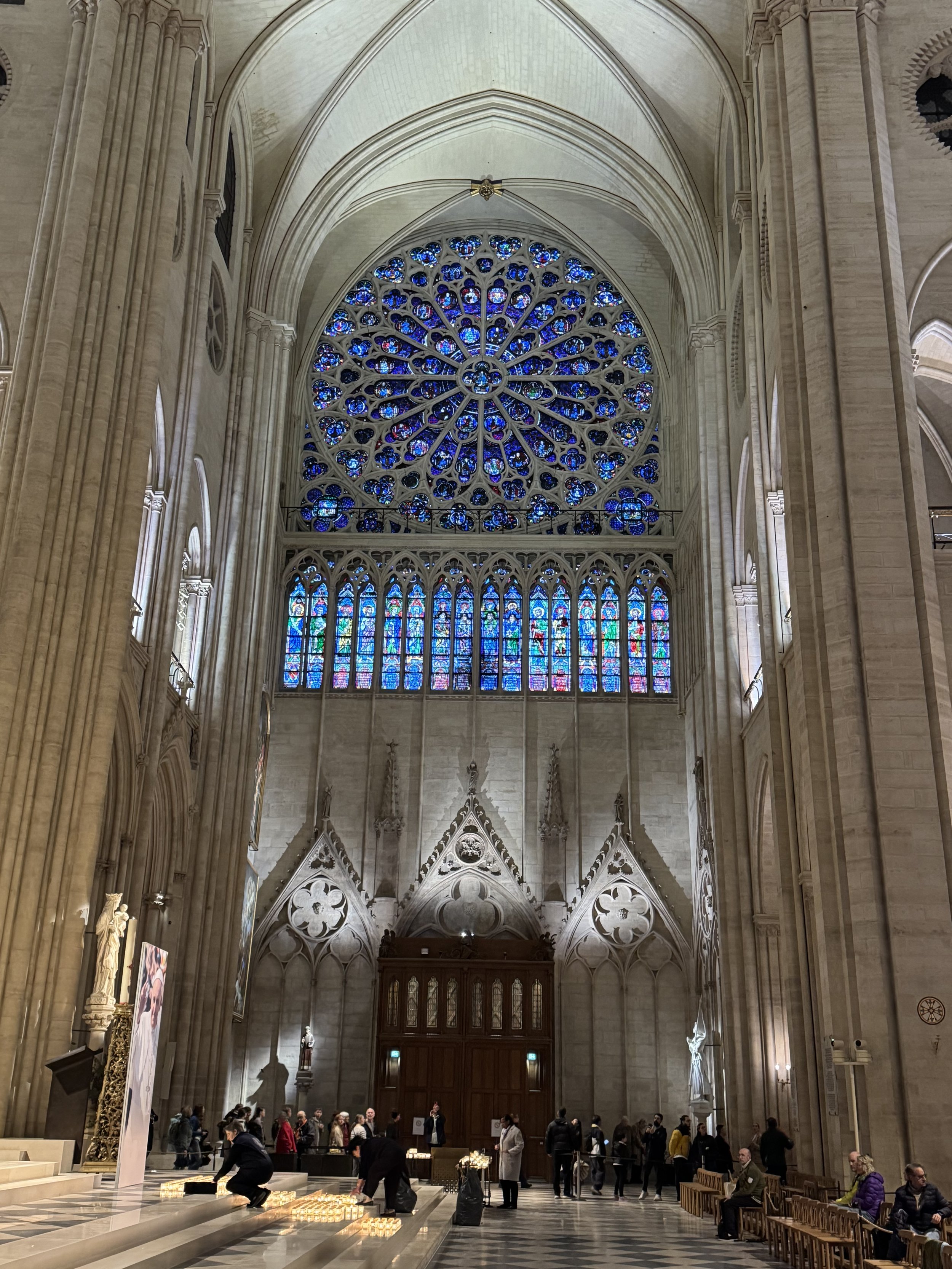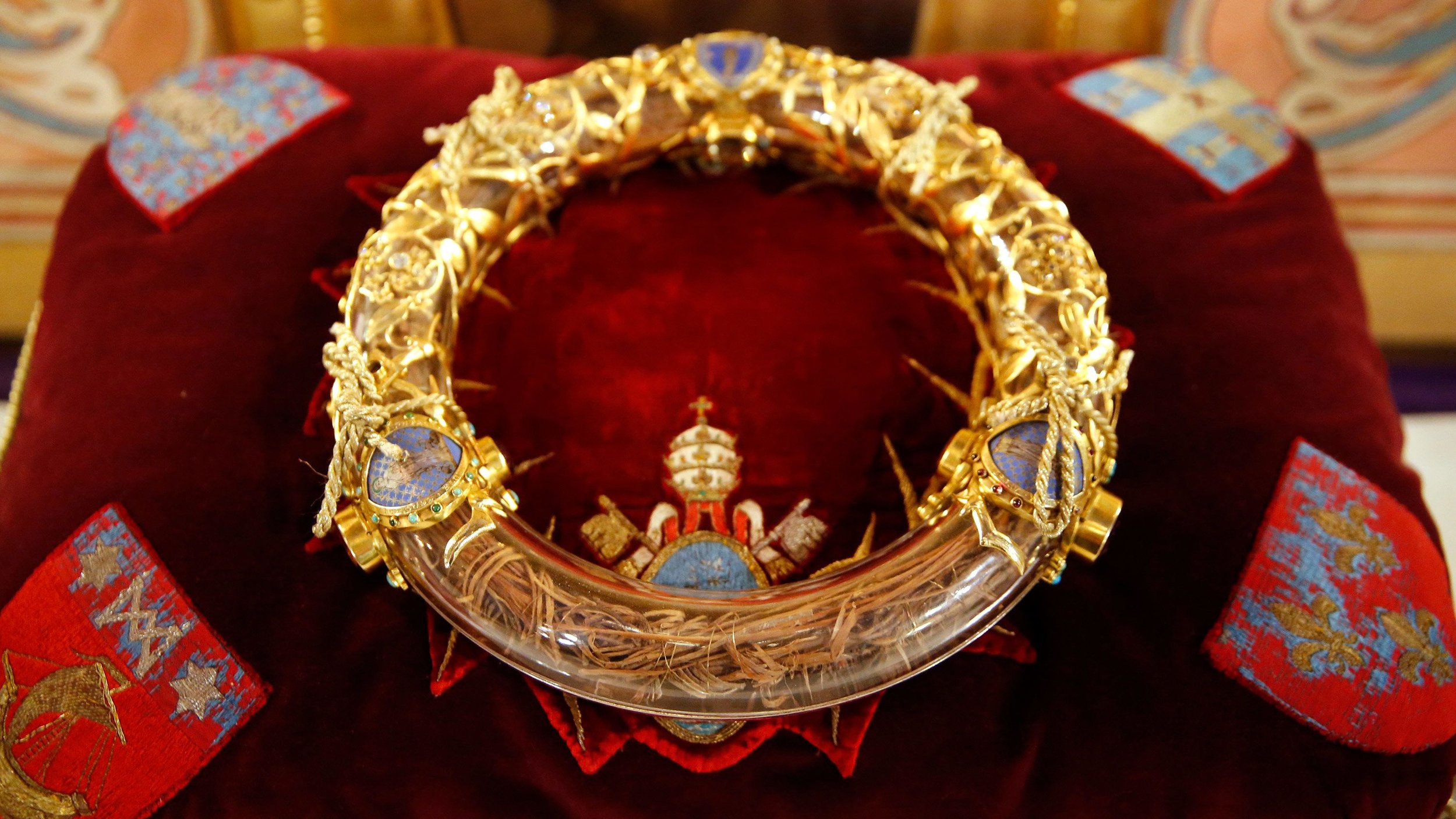Notre-Dame & l’Orangerie
After the day of mourning messed up our plans to visit Notre-Dame on Tuesday, Wednesday was our final shot at getting inside. It was a bit like the Walking in Memphis song as we made our way there “in the middle of a pouring rain.” Gratefully, between being earlier in the morning and the rain, there was no queue. However, they still had us run through the full maze of back-and-forth queuing barriers like lab rats, just to ensure we were good and soaked through by the time we made it inside.
Notre-Dame is a French phrase meaning Our Lady.
It will come as no surprise that Catholics place tremendous importance on Mary, a fact that is reflected throughout the cathedral.
The large memorial for Pope Francis.
Notre-Dame Cathedral boasts three magnificent rose windows over its main portals. This is the South Window, also known as the “south rose” or the “midday rose.” It was given to Notre-Dame Cathedral by the King of France Saint Louis IX in 1260. Its theme is the Last Judgment.
The North Rose Window was crafted around 1250. It is the only rose window to retain its original glass, with most of the 13th century glasswork still intact. It depicts Mary enthroned holding the Christ Child. Surrounding them are images of kings and prophets of the Old Testament, with 16 prophets in the inner circle of medallions and 32 kings and judges in the outer circle.
The reverse of both sides of the choir are covered in detailed screens of various Bible stories. The partial relief on the left is the wedding in Cana, followed by the entry of Jesus into Jerusalem on a donkey, and the Last Supper.
Mary, pregnant with Jesus, visiting her cousin Elizabeth, herself pregnant with John the Baptist.
The risen Christ (holding a shovel?) appears to Mary Magdalene.
The high alter features a sculpture of the Blessed Virgin Mary holding her crucified son with angels attending. A gold cross, which does not have the figure of Christ hanging on it, stands above. Out of devotion to the Virgin Mary, King Louis XIII wished to have a new high altar constructed for Notre-Dame. This vow was realized by Louis XIV in the 18th century. To honor both kings, the statue on the right is of Louis XIII, kneeling, offering his royal crown to the Virgin. Just barely visible on the left is Louis XIV in coronation attire imploring the Virgin, with his right hand on his chest.
Though blacked with soot, miraculously the high alter survived the ravages of the massive 2019 fire.
Notre-Dame Cathedral claims to hold relics that include Jesus’ crown of thorns, a nail from the True Cross, and a sliver of the True Cross.
The relics are held inside this reliquary, an altarpiece of marble and cedar wood. The radiant halo symbolizes Notre-Dame’s rebirth as a cathedral of light.
On December 13, 2024, the crown of thorns was returned to Notre-Dame, marking a deeply moving moment for Parisians and pilgrims alike. The relic, which survived the devastating 2019 fire, had been stored at the Louvre since the blaze. The return procession, attended by over 400 members of the Equestrian Order of the Holy Sepulcher, saw the crown—held by a knight in full regalia—walk from the Louvre to Notre-Dame, drawing crowds of onlookers. Surrounding the crown are intricately designed gilded bronze thorns, evoking the crown’s Byzantine roots.
The crown, acquired by King Louis IX in 1239, was originally housed at Sainte-Chapelle before being moved to Notre-Dame in 1806. Beginning on January 10 of this year, the crown is displayed every Friday (as shown above). We were not in Paris on a Friday, and so could not have seen it on display.
I found The Count and Countess of Harcourt sculpture strangely captivating. Henri-Claude d’Harcourt was the sixth son of Henri, Duke of Harcourt, Marshal of France, who passed away in 1718. A count and lieutenant-general of the king’s armies. Upon his death in 1769, his widow, Marie-Magdeleine Thibert des Martrais, Countess of Chiverny, wished to honor him. Her wealth allowed her to commission a renowned artist: the sculptor Jean-Baptiste Pigalle.
Her instructions to Pigalle: “At one end of the sarcophagus will be the guardian angel of the said Lord Count of Harcourt who, seeing the said Lady Countess of Harcourt approaching, will lift the stone of the tomb with one hand and hold the torch of Hymen [wedding torch] with the other; Mr. the Count, who, after appearing to come back to life for a moment by the warmth of his torch, will free himself from his shroud and extend his languishing arms to his wife… Behind Mr. the Count will be Death holding a hourglass to show Mrs. the Countess that her time has come. Mrs. the Countess, at the foot of the sarcophagus, will express through her posture the impatience she has to reunite with her husband; at the sight of this reunion, the guardian angel will extinguish the torch of Hymen [wedding torch].”
The cathedral has been beautifully restored following the fire and I’m so glad we were able to visit. I’m sure many will be upset by my next comment, but my overall impression was ho-hum. Of the many cathedrals we have visited, this was one of the least interesting, I’m sorry to say. Perhaps on such a drab and dreary day there was no light streaming in through the many stained-glass windows. Whatever the cause, my overall impression was underwhelm.
Just outside of Notre-Dame Cathedral embedded in the concrete of the public square is a small geographic marker known as Kilometer Zero. It is the starting point from which distances are measured to other cities in France. The marker reads, “Point zero for the roads of Paris.” This point was established by King Louis XV in 1769. The brass plaque from the center was likely removed while heavy construction was underway on the cathedral and replaced with this metal plate. Presumably, the brass plaque will be returned soon, as construction is winding down.
About 1/10 of a kilometer from Kilometer Zero on the Left Bank of the Seine is the Shakespeare and Company Bookstore, which routinely advertises its location within the radius of Kilometer Zero Paris.
After the locks were removed from Pont des Arts (bridge), people have found many other places to leave their Parisian love locks.
One more thing on our list: see Monet’s Water Lilies. We were less fortunate when queuing to get inside the Musée de l'Orangerie. After an hour standing in the rain, we finally made it inside.
Though while standing in line we questioned several times whether it was worth it or not, we were very glad we stuck it out. To see the murals in person is an exceptional experience.
From the very beginnings of his great project, Monet imagined a panoramic arrangement "enveloping the whole interior in its unity.”
The Musée de l'Orangerie houses eight of the great Nymphéas (Water Lilies) compositions, created from panels assembled side by side. These compositions are all the same height (6.5 feet) and are hung across the curved walls of the two elliptical rooms, enhanced by the east-west alignment of the museum and natural light filtering in through the ceiling.
In the end, by drawing up successive plans for the space that would accommodate the Water Lilies, he was able to clarify and refine his ideas, moving "from a circle to an oval, and finally to a double ellipse [two adjoining rooms] forming the symbol for infinity.”
We particularly enjoyed the panels with trees.
After the museum we finally had breakfast, and then returned to our apartment to pack and get ready for our Thursday departure from Paris and return to London.






























